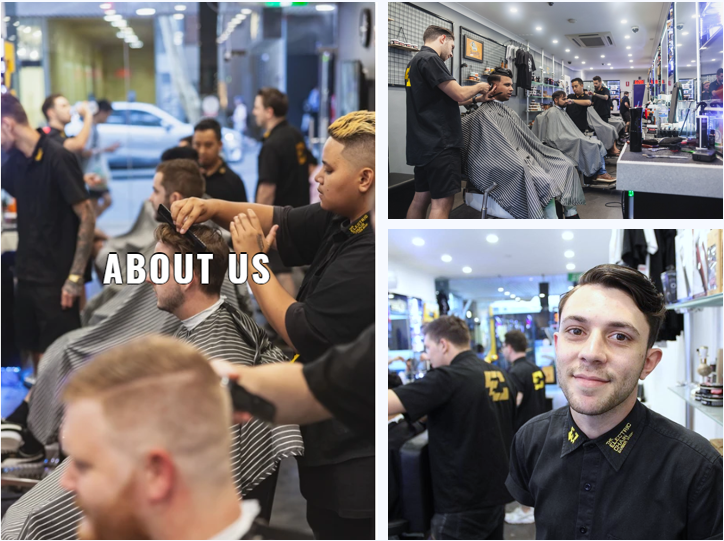Brand Positioning Pitch
- Lucinda Kittel

- Feb 26, 2021
- 7 min read
A small snippet taken from a Brand Positioning Pitch I developed for The Electric Chair Barbershop (TEC).

This report will review The Electric Chair Barbershop brand and its current position in the market, the target market, competitors, points of parity and difference, along with discussing and integrating the CBBE model, multiple frames of reference and the criteria for choosing brand elements. The Electric Chair Barbershop, founded by Adrian Messina, opened its doors the year of 2013, in Brisbane CBD on Adelaide Street, to which they quickly established themselves as a go-to destination for modern male grooming (The Electric Chair Barbershop, 2020). TEC soon grew to have three stores across Brisbane, thanks to their loyal customers (The Electric Chair Barbershop, 2020).
TEC was developed with the idea in mind of bringing something modern and new to the old school practice of barbering (The Electric Chair Barbershop, 2020). They offer services that cover all men’s styles, from slick and smooth to messy and texture with the guarantee that no one will find anyone else like them and their brand. (The Electric Chair Barbershop, 2020)
Target Market
A brand relies on its offers and image, as it provides a distinct and valued place in the target customers' minds (week 1, slide 41). A survey was conducted via SoGo Survey, where information supporting market segmentation and its distinct groups of homogeneous consumers were considered in the collection of data. Data shows the demographic market for Electric Chair Barbershop as predominantly males between the ages of 18-24, with results showing 75%. Data also shows the respondents are all living out of home, with 60% of respondents’ income at $10,000 – $30,000. From a geographical standpoint respondent’s whereabouts showed 50% were situated on the Northsides of Brisbane and 50% on the Southside of Brisbane. 75% of respondents said they are very likely to travel the distance for a well-recommended barbershop like TEC.
In moving over to a psychographic standpoint, 75% said they were very positive about how they feel about barbershops. In response to how frequently they think about the brand, 75% of respondents rated a 4 which is in between sometimes and quite frequently. respondent’s overall opinion of the brand included “great store”, “I’ve heard it spoken highly of by people I trust” and “amazing”. Respondents behaviour towards TEC remains positive, as results suggest that this brand is sought after, with 75% of respondents saying they are always visiting this specific barbershop. In asking where they would normally go to get their haircuts, the response was 100% barber.
Nature of Competition and Integration of the CBBE model
The relation that lays between brands and brand resonance is that brand resonance refers to the relationship between brand and its users, including the consumers’ willingness to purchase and to recommend that brand to others (Panigrahi Kumari Anita, 2015) . Brand resonance involves the psychological bond that customers have with the brand as well as how much engagement this loyalty provokes (Panigrahi Kumari Anita, 2015). Through research, TEC’s competitors include Bous For Men Barber Shop and Col Nayler Barber Shop. The first building block is ‘salience’, which can be defined as “more than mere awareness of a brand in a product category and is vital for a brand to remain in one’s consideration set” (Vieceli Julian & Shaw N. Robin, 2010). The Electric Chair Barbershop and Col Nayler both share a similar level of brand salience, in the sense that their brand visuals and wide range in services are what customers associate with each of the brands. Brand performance is associated with having a product or service that meets the customers’ functional needs (Panigrahi Kumari Anita, 2015). TEC meets its customer's functional needs in a way of providing great cuts and service at an affordable price. TEC’s competitors meet their customer's functional needs by also supplying great customer service, experience and being named a market leader in men’s hairdressing with good prices. This shows that men predominantly value a great level of customer service that comes with a great experience at reasonable prices when considering a barbershop. Brand Imagery is the third building block and relates to the extrinsic properties of the product (Panigrahi Kumari Anita, 2015). Brand image is well represented, as 25% of respondents strongly agreed that they almost felt as if they belonged to a club. TEC also represent themselves well through their stylish, modern pop culture approach. Both Col Nayler and Bous’s brand imagery represents self-confidence, being stylish and sociable while expressing male dominance. If all of these brand image factors were combined for TEC’s brand, this would help drive brand equity and purchase results based on differentiation (Vieceli Julian & Shaw N. Robin, 2010).
Brand judgements focuses on customers’ personal opinions and evaluations (Panigrahi Kumari Anita, 2015). The judgements can be based on; quality, credibility, considerations, and superiority (week 2, slide 17). Customers express their opinions of the brand to be their go-to destination where they’re involved in a fully immersive experience. Tec’s other competitors are judged on their level of quality and trustworthiness, in which these factors alone can evoke different levels of consumers’ brand awareness and brand associations (Chatzipanagiotou Kalliopi & Christodoulides george et al., 2019). Brand feelings are customers' emotional responses and reactions towards the brand (Panigrahi Kumari Anita, 2015). TEC has tried creating an addictive atmosphere to provoke word of mouth among its most loyal customers to gain further attraction. TEC’s competitors aim for customers leaving feeling refreshed and confident, knowing they enjoyed the service.The six important types of brand -building feelings should be considered. these include warmth, fun, excitement, security, social approval, and self-respect. These feelings represent a brand strongly associated with being accessible for use (Raut Ramchandra Umesh, 2015). According to (Panigrahi Kumari Anita, 2015), brand resonance refers to the nature of the customer-brand relationship and the extent to which customers feel that they are “in sync” with the brand. For TEC, brand resonance is having loyal customers who leave with strong, positive perceptions of the brand. As for its competitors, Cole Nayler and Bous focus on maintaining their loyal customers. It is important to understand how the customers perceive the brand (think, feel and act) to develop sequential steps towards building a better brand (Panigrahi Kumari Anita, 2015). Frame of reference links with brand resonance, regarding brand experience, defining goals of target markets, the process in selecting a brand, and identifies the brands closest competitors who may have similar attributes in achieving customer satisfaction (Janiszewska Karolina & Insch Andrea, 2012).
The Electric Chair Barber Shop currently sells four ranges of hair products that support their current services. These four products, therefore, involve TEC in having a direct competition with other barbershops that use and sell these exact products to their customers. However, indirect competition for TEC includes brands like; Stefan, Toni & Guy, and Evogue Hair
Understanding whether there is a strong and positive association between the customer and the brand links with identifying the brands current position in the market. Mitesh & Pauja states that anything linked to a brand is referred to as brand associations and is believed to be an element of equity (Jayswal Mitesh & Vora Pauja, 2019).
Research was conducted to understand customer's associations towards barbershops. Data shows direct associations and feelings associated with the experience of the barbershops which have been displayed here in the table. Some of the associations have been used in the creation of the positioning maps that can be seen here Identifying and understanding the associations regarding The Electric Chair Barber Shop help to suggest the proper language and phrasing to be used for a brand internally within the industry. This is applied to creating a brand mantra. They are usually short three to five-word phrases that capture the whole essence of the brand positioning (Lane Keller Kevin, 1999) .
According to Lane (1999), brand mantras serve a great purpose in guiding as to what products to introduce under the brand, what ad campaigns to run and how the brand should be sold (Lane Keller Kevin, 1999). The Electric Chair’s current brand mantra is a succinct sentence that encapsulates the core characteristic of the brand, which has been expressed in a simple, clear way; “passion. Determination. Work.”. TEC’s brand mantra connects and communicates directly with the customer through expressing the brand benefit and the result in an emotional, relatable and unique way.

TEC’s product descriptor serve as unique, with not only its ‘brand name’ but its imagery can generate images beyond the actual product. This is demonstrated by the elaborate golden E, the word ‘electric’, typography, colour, finishes and the embossing of the words.

Consumers over a period of time can identify the brand through brand elements. According to (Farhana Mosarrat, 2012) brand elements when chosen correctly, can both enhance brand awareness and facilitate information of strong, favourable, and unique brand associations. Therefore, a table has been developed to identify whether The Electric Chair Barbershop’s current brand elements meet some criteria:

Each brand element will have its own strengths and weaknesses (Farhana Mosarrat, 2012). These strengths and weaknesses can lead to opportunities for TEC, in developing multiple marketing strategies around them, where it may be that experiences are made to be more memorable, packaging created to look more meaningful to its consumers and developing a tagline that is more adaptable. Therefore, creating a richer, more memorable brand experience for their customers, and having built a truly positive brand identity.
Points of Parity and Points of Difference
Although brands tend to focus solely on the company’s points of difference, it is important to also consider the points of parity to fully preserve a brand and ensure they come out on top, when compared to their competitors (Carlsson Carolina & Linander Kristina, 2012). According to Carlsson & Linander (2012) it is harder to take the position of a point of parity than it is to take ownership of point of difference, due to the competition being lower (Carlsson Carolina & Linander Kristina, 2012).

Points of parity and points of difference between each competitor have been identified in the form of a table. It is evident TEC and its competitors share physical differences that come down to their performance, structure, sustainability, dependability, looks, and packaging.

Points of difference are greatly favourited by organisations when developing positioning strategies, as points of parity are deemed a longer process overall (Carlsson Carolina & Linander Kristina, 2012). TEC’s distinct features are its vibrant use of imagery, complimentary goods, gift vouchers and the fact that they advertise about cutting female's hair.
TEC may want to implement some of their competitors’ differences into their brand, which can lead to developing further positioning strategies that provide TEC with an advantage against its competitors in the long run.
Appendices

Thank You for Reading!
© 2021 Lucinda Kittel. All rights reserved.

























Comments